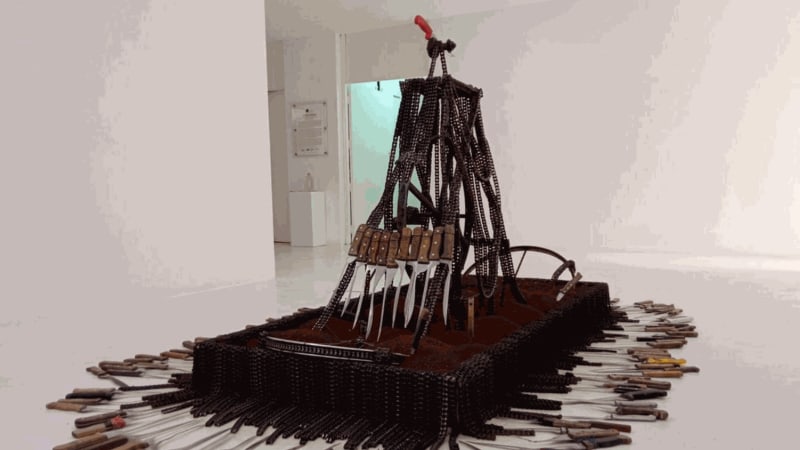Ca’ del Duca 3052, Corte del Duca Sforza
San Marco, 30124, Venezia, Italy
Tue – Sat 10am – 6pm
A metallic installation by the Kenyan multimedia artist Ngugi Waweru derives its title from a Kikuyu proverb, “Kahio kogi gatemaga o mwene” (a sharp knife cuts the owner) which warns against the possibility of being harmed by one’s own decisions.
Ngugi says his installation which is made of used knives, motorbike chains, and corrugated iron sheets is about the human quest for advancement in various spheres — technology, education, religion, economies, colonising other planets, among others, which is also marked by a growing distance between people and the qualities that make us human beings — our capacity for love, kindness, care, understanding, sharing, and community.
“Just as a knife is eroded as it is sharpened repeatedly so that it can perform its functions better, so are we made less and less human by the actions we take to adopt and survive within our present society,” Ngugi says.
Unlike most artists who find their art aptitude in primary school, Ngugi, who was born and grew up in Nairobi, where he currently lives and works, learned from observation and experience working mostly in woodcut prints and mixed medium painting on canvas.
“My influences are first and foremost anything I see and feel, and I encounter. When I am working on the rough texture on my canvas, it reminds me of the struggle we all go through and our inner strength and knowledge that we use to overcome our challenges,” Ngugi says.
His installation is part of the four-month large site-specific exhibition that opened on May 20, and will close on October 1, at the Ca’ Pesaro International Gallery of Modern Art in Venice, Italy.
The “Africa 1:1” exhibition is the result of a collaborative project brought forward by AKKA Project, Africa First, and Ca’ Pesaro which, in the spirit of the 18th Architecture Biennale, created Africa 1:1 Lab, Artists Residency Programme, an artist residency project that brought five young African artists to experience the vibrant Venetian artistic environment and, at the same time, to offer their creative contribution to the city, which is preparing for the 18th Architecture Biennale’s “Laboratory of the Future'' curated by Lesley Lokko.
The other four contemporary African artists who took part in the residency programme designed to nurture and showcase the talents of the artists held at the AKKA Project premises in Venice from March 15 to May 18, 2023, are Option Nyahunzvi (Zimbabwe), Pamela Enyonu (Uganda), Alexandre Kyungu (DR Congo), and Boniface Maina (Kenya).
Through the study of the gallery’s history, the original documents, and artists’ works in the permanent collection, the five artists-in-residence constructed new dialogues with the city’s visual tradition and with the history of the Palazzo on the Grand Canal. Each artist brings their unique perspective and creative vision to this remarkable collaboration.
Nyahunzvi’s painting titled “Tormented Soul” depicts one human figure facing down while the other is facing up and seems to be meditating.
Nyahunzvi’s artistic practice is deeply rooted in the spiritual beliefs of his Shona culture. His works often focus on the relationship between ancestral spirits and the living, exploring themes of community, tradition, and identity. He uses his art to connect with his cultural heritage and to express his own spiritual beliefs, creating pieces that are both personal and universal in their appeal.
Enyonu’s painting “Edna” shows a woman with her right hand holding her chin while the left-hand rests on her chest. The work depicts a woman in total control of her body and self.
The series begins with a poem called “A Daughter’s Prayer.” In the fashion of how the Christian Lord’s Prayer is recited, Enyonu writes her own which beseeches a Divine Mother. It touches on themes of patriarchal ownership of women’s bodies, agency, and power to exercise choice.
“The visual manifestation of the series works with a playful but mature palette, the figures interact with orb-like shapes as one would with a ball. It’s a nostalgic throwback to a time when we believed anything was possible,” Enyonu says.
Kyungu’s project “Scars of the Earth” combines painting, drawing, sculpture, and installation. The artist uses rubber as a medium for his work to link the theme of cartography and body scarification. He explores and addresses notions of migration and identity, borders and space, and signs and symbols.
Maina’s drawing “Social Zombification” with zombie-like human figures represents the effects of social media and the internet on contemporary society.
Maina’s drawings are done in acrylic paint and inks whereby the backgrounds are created using a registration technique similar to the linoleum printmaking process by painting a thin layer of paint color on coated cardboard and then placing it on the watercolor paper at specific points to make a flowing yet coarse background.
When the paint is dry, inks are then layered thinly using a soft brush to make the filmy undertone. After drying, the composition begins with every figure drawn using a line as the element that defines the form and depth, light, and shadows of the figures.
“The exhibition showcases the work of our talented resident artists who have been working tirelessly to bring their unique visions to life. We believe their work is sure to captivate and inspire, and we are thrilled to have the opportunity to share it with you,” the AKKA Project co-founder Lidija Kostic Khachatourian says.





